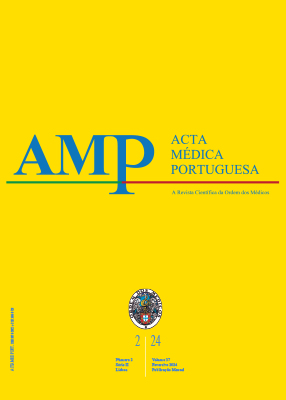Night-Time Noise and Sleep Quality in an Internal Medicine Ward in Portugal: An Observational Study
DOI:
https://doi.org/10.20344/amp.19042Keywords:
Hospital Departments, Inpatients, Internal Medicine, Noise, Sleep DeprivationAbstract
Introduction: Hospitals should provide a quiet environment to promote patient healing and well-being. However, published data indicates that World Health Organization’s guidelines are frequently not met. The aim of the present study was to quantify night-time noise levels in an internal medicine ward and evaluate sleep quality, as well as the use of sedative drugs.
Material and Methods: Prospective observational study in an acute internal medicine ward. Between April 2021 and January 2022, on random days, noise was recorded using a smartphone app (Apple® iOS, Decibel X). Night-time noise was recorded from 10 p.m. to 8 a.m. During the same period, hospitalized patients were invited to respond to a questionnaire regarding their sleep quality.
Results: A total of 59 nights were recorded. The average noise level recorded was 55 dB with a minimum of 30 dB and a maximum of 97 dB. Fifty-four patients were included. An intermediate score for night-time sleep quality (35.45 out of 60) and noise perception (5.26 out of 10) was reported. The main reasons for poor sleep were related to the presence of other patients (new admission, acute decompensation, delirium, and snoring), followed by equipment, staff noise and surrounding light. Nineteen patients (35%) were previous users of sedatives, and during hospitalization 41 patients (76%) were prescribed sedatives.
Conclusion: The noise levels detected in the internal medicine ward were higher than the levels recommended by the World Health Organization. Most patients were prescribed sedatives during hospitalization.
Downloads
References
Wesselius HM, Van Den Ende ES, Alsma J, ter Maaten JC, Schuit SC, Stassen PM, et al. Quality and quantity of sleep and factors associated with sleep disturbance in hospitalized patients. JAMA Intern Med. 2018;178:1201-8. DOI: https://doi.org/10.1001/jamainternmed.2018.2669
Berglund B, Lindvall T, Schwela DH. Guidelines for community noise. Geneva: WHO; 1999. DOI: https://doi.org/10.1260/0957456001497535
McLaren E, Maxwell-Armstrong C. Noise pollution on an acute surgical ward. Ann R Coll Surg Engl. 2008;90:136–9. DOI: https://doi.org/10.1308/003588408X261582
Hulland T, Su A, Kingan M. Noise in an inpatient hospital ward in New Zealand. Build Acoust. 2020;27:299–309. DOI: https://doi.org/10.1177/1351010X20916120
Shield B, Shiers N, Glanville R. The acoustic environment of inpatient hospital wards in the United Kingdom. J Acoust Soc Am. 2016;140:2213–24. DOI: https://doi.org/10.1121/1.4962276
Santos J, Carvalhais C, Xavier A, Silva M. Assessment and characterization of sound pressure levels in Portuguese neonatal intensive care units. Arch Environ Occup Health. 2018;73:121–7. DOI: https://doi.org/10.1080/19338244.2017.1304883
Alves M, Távora C, Silva JF, Gomez N, Fonseca T. To how much noise are we exposing hospitalized elderly patients during sleep? Acta Med Port. 2021;34:711–2. DOI: https://doi.org/10.20344/amp.16353
Kardous CA, Shaw PB. Evaluation of smartphone sound measurement applications. J Acoust Soc Am. 2014;135:EL186–92. DOI: https://doi.org/10.1121/1.4865269
Yelden K, Duport S, Kempny A, Playford ED. A rehabilitation unit at night: environmental characteristics of patient rooms. Disabil Rehabil. 2015;37:91–6.
White B, Snyder HS, Patel MV. Evaluation of medications used for hospitalized patients with sleep disturbances: a frequency analysis and literature review. J Pharm Pract. 2021:089719002110178. DOI: https://doi.org/10.1177/08971900211017857
Garside J, Stephenson J, Curtis H, Morrell M, Dearnley C, Astin F. Are noise reduction interventions effective in adult ward settings? a systematic review and meta analysis. Appl Nurs Res. 2018;44:6–17. DOI: https://doi.org/10.1016/j.apnr.2018.08.004
Yelden K, Duport S, Kempny A, Playford ED. A rehabilitation unit at night: environmental characteristics of patient rooms. Disabil Rehabill. 2015;37:91–6. DOI: https://doi.org/10.3109/09638288.2014.906662
Oliveira L, Gomes C, Bacelar Nicolau L, Ferreira L, Ferreira R. Environment in pediatric wards: light, sound, and temperature. Sleep Med. 2015;16:1041–8. DOI: https://doi.org/10.1016/j.sleep.2015.03.015
Hshieh TT, Yang T, Gartaganis SL, Yue J, Inouye SK. Hospital elder life program: systematic review and meta-analysis of effectiveness. Am J Geriatr Psychiatry. 2018;26:1015–33. DOI: https://doi.org/10.1016/j.jagp.2018.06.007
Madeira Marques P, Silva MS, Lambelho AR, Bartissol B, Gorjão Clara J. Plano hospitalar para idosos - prevenção do delirium e do imobilismo e otimização da assistência. Lisbon: Lidel; 2022.
Alves M, Macedo IM, Távora C, Silva JF, Fonseca T. Sleep disturbances management in elderly hospitalized patients. J Pharm Pract. 2021;8971900211053287. DOI: https://doi.org/10.1177/08971900211053287
Alves M, Miranda AN, Lopes FT, Dias AR, Narciso MR, Fonseca TP, et al. Polypharmacy is still a problem in Portuguese old patients. What is the effect of hospital admission in modification of potentially inappropriate chronic medication prescription? Eur Geriatr Med. 2013;4:S29. DOI: https://doi.org/10.1016/j.eurger.2013.07.095
Downloads
Published
How to Cite
Issue
Section
License
Copyright (c) 2023 Acta Médica Portuguesa

This work is licensed under a Creative Commons Attribution-NonCommercial 4.0 International License.
All the articles published in the AMP are open access and comply with the requirements of funding agencies or academic institutions. The AMP is governed by the terms of the Creative Commons ‘Attribution – Non-Commercial Use - (CC-BY-NC)’ license, regarding the use by third parties.
It is the author’s responsibility to obtain approval for the reproduction of figures, tables, etc. from other publications.
Upon acceptance of an article for publication, the authors will be asked to complete the ICMJE “Copyright Liability and Copyright Sharing Statement “(http://www.actamedicaportuguesa.com/info/AMP-NormasPublicacao.pdf) and the “Declaration of Potential Conflicts of Interest” (http:// www.icmje.org/conflicts-of-interest). An e-mail will be sent to the corresponding author to acknowledge receipt of the manuscript.
After publication, the authors are authorised to make their articles available in repositories of their institutions of origin, as long as they always mention where they were published and according to the Creative Commons license.









